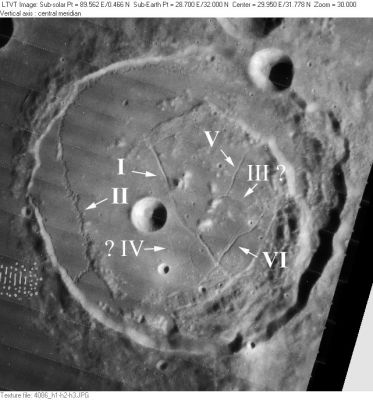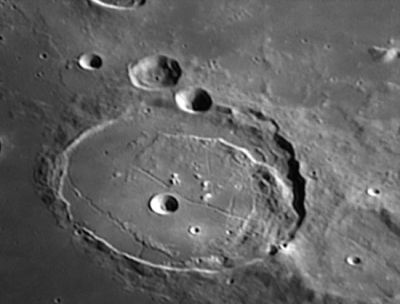Difference between revisions of "Rimae Posidonius"
| (2 intermediate revisions by the same user not shown) | |||
| Line 6: | Line 6: | ||
|- | |- | ||
| | | | ||
| − | [http://www.lpod.org/coppermine/displayimage.php?pid=3485&fullsize=1 [[Image: | + | [http://www.lpod.org/coppermine/displayimage.php?pid=3485&fullsize=1 [[Image:Normal_Rimae-Posidonius_LO-IV-086H_LTVT.JPG|external image normal_Rimae-Posidonius_LO-IV-086H_LTVT.JPG]]]<br /> |
| | | | ||
| − | [http://www.lpod.org/coppermine/displayimage.php?pid=401&fullsize=1 [[Image: | + | [http://www.lpod.org/coppermine/displayimage.php?pid=401&fullsize=1 [[Image:Normal_Posidonius-050406-2043.0.jpg|external image normal_Posidonius-050406-2043.0.jpg]]]<br /> |
|} | |} | ||
Left: ''[http://lpod.org/coppermine/displayimage.php?pos=-3485 LO-IV-086H]'' Aerial view showing classic rille numbers. Right: ''[http://lpod.org/coppermine/displayimage.php?pos=-401 Mick Hyde]'' Earth-based view.<br /> <br /> <div id="toc"> | Left: ''[http://lpod.org/coppermine/displayimage.php?pos=-3485 LO-IV-086H]'' Aerial view showing classic rille numbers. Right: ''[http://lpod.org/coppermine/displayimage.php?pos=-401 Mick Hyde]'' Earth-based view.<br /> <br /> <div id="toc"> | ||
| − | + | ||
| − | |||
==Images== | ==Images== | ||
[http://www.lpod.org/coppermine/thumbnails.php?album=search&type=full&search=Rimae%20Posidonius LPOD Photo Gallery] [http://www.lpi.usra.edu/resources/lunar_orbiter/bin/srch_nam.shtml?Rimae%20Posidonius%7C0 Lunar Orbiter Images]<br /> | [http://www.lpod.org/coppermine/thumbnails.php?album=search&type=full&search=Rimae%20Posidonius LPOD Photo Gallery] [http://www.lpi.usra.edu/resources/lunar_orbiter/bin/srch_nam.shtml?Rimae%20Posidonius%7C0 Lunar Orbiter Images]<br /> | ||
| Line 21: | Line 20: | ||
''([[LAC%20zone|LAC zone]] 26C3)'' [http://www.lpi.usra.edu/resources/mapcatalog/LAC/lac26/ LAC-26] and [http://www.lpi.usra.edu/resources/mapcatalog/LAC/lac42/ LAC-42]; [http://www.lpi.usra.edu/resources/mapcatalog/usgs/I705/ Geologic map I-705] and [http://www.lpi.usra.edu/resources/mapcatalog/usgs/I489/ Geologic map I-489]<br /> <br /> | ''([[LAC%20zone|LAC zone]] 26C3)'' [http://www.lpi.usra.edu/resources/mapcatalog/LAC/lac26/ LAC-26] and [http://www.lpi.usra.edu/resources/mapcatalog/LAC/lac42/ LAC-42]; [http://www.lpi.usra.edu/resources/mapcatalog/usgs/I705/ Geologic map I-705] and [http://www.lpi.usra.edu/resources/mapcatalog/usgs/I489/ Geologic map I-489]<br /> <br /> | ||
==Description== | ==Description== | ||
| − | System of rilles on the floor of [[Posidonius|Posidonius]]. A somewhat unusual mix of the linear rilles characteristic of [[floor%20fractured%20craters|floor fractured craters]] and the sinuous rilles characteristic of lava channels. <span class="membersnap">- | + | System of rilles on the floor of [[Posidonius|Posidonius]]. A somewhat unusual mix of the linear rilles characteristic of [[floor%20fractured%20craters|floor fractured craters]] and the sinuous rilles characteristic of lava channels. <span class="membersnap">- JimMosher</span><br /> <br /> |
===Wikipedia=== | ===Wikipedia=== | ||
[http://en.wikipedia.org/wiki/Rimae_Posidonius Rimae Posidonius]<br /> <br /> | [http://en.wikipedia.org/wiki/Rimae_Posidonius Rimae Posidonius]<br /> <br /> | ||
| Line 27: | Line 26: | ||
* IAU page: [http://planetarynames.wr.usgs.gov/Feature/5133 Rimae Posidonius] | * IAU page: [http://planetarynames.wr.usgs.gov/Feature/5133 Rimae Posidonius] | ||
| − | * Based on [http://www.lpi.usra.edu/resources/lunarorbiter/frame/?4086 LO-IV-086H], Rille I is about 50 km long and 1.1 km wide over most of its length, but broadening to 1.7 km wide near its middle. Rilles II, V, and VI are mostly in the range 0.8-0.9 km wide. Rille II is extremely sinuous over most of its length, but appears to include a relatively straight, but very narrow, stretch hugging the base of Posidonius inner west wall from about the 8 o'clock to the 9 o'clock position (ending at the gap in the wall). Including this 31 km long segment, and the 47 km segment at the foot of the inner north wall, its total length (not counting the tiny twists) is about 135 km. <span class="membersnap">- | + | * Based on [http://www.lpi.usra.edu/resources/lunarorbiter/frame/?4086 LO-IV-086H], Rille I is about 50 km long and 1.1 km wide over most of its length, but broadening to 1.7 km wide near its middle. Rilles II, V, and VI are mostly in the range 0.8-0.9 km wide. Rille II is extremely sinuous over most of its length, but appears to include a relatively straight, but very narrow, stretch hugging the base of Posidonius inner west wall from about the 8 o'clock to the 9 o'clock position (ending at the gap in the wall). Including this 31 km long segment, and the 47 km segment at the foot of the inner north wall, its total length (not counting the tiny twists) is about 135 km. <span class="membersnap">- JimMosher</span> |
<br /> | <br /> | ||
==Nomenclature== | ==Nomenclature== | ||
| Line 34: | Line 33: | ||
* Number 162 in Debra Hurwitz's Atlas and Catalog of Sinuous Rilles. | * Number 162 in Debra Hurwitz's Atlas and Catalog of Sinuous Rilles. | ||
* The original IAU nomenclature of [[Blagg%20and%20M%C3%BCller|Blagg and Müller]] included five Roman-numeraled rilles within [[Posidonius|Posidonius]]. | * The original IAU nomenclature of [[Blagg%20and%20M%C3%BCller|Blagg and Müller]] included five Roman-numeraled rilles within [[Posidonius|Posidonius]]. | ||
| − | * The identifications given in the Lunar Orbiter image at the top of this page are based on the numbering in ''[[System%20of%20Lunar%20Craters|System of Lunar Craters]]'' maps [http://www.glrgroup.org/domes/mapdome/b2.htm B2] and [http://www.glrgroup.org/domes/mapdome/b3.htm B3] and on NASA charts [http://www.lpi.usra.edu/resources/mapcatalog/LAC/lac26/ LAC-26] and [http://www.lpi.usra.edu/resources/mapcatalog/LAC/lac42/ LAC-42]. The indended identity of rilles III and IV is somewhat ambiguous. There are two rille segments near the "? IV" label, one probably an extension of V. It is unclear which the number is intended to refer to, but most probably it is the one on the left running towards '''Posidonius A'''. Similarly, there are several rilles near the "III ?" label, and it is unclear which the name was meant to refer to. <span class="membersnap">- | + | * The identifications given in the Lunar Orbiter image at the top of this page are based on the numbering in ''[[System%20of%20Lunar%20Craters|System of Lunar Craters]]'' maps [http://www.glrgroup.org/domes/mapdome/b2.htm B2] and [http://www.glrgroup.org/domes/mapdome/b3.htm B3] and on NASA charts [http://www.lpi.usra.edu/resources/mapcatalog/LAC/lac26/ LAC-26] and [http://www.lpi.usra.edu/resources/mapcatalog/LAC/lac42/ LAC-42]. The indended identity of rilles III and IV is somewhat ambiguous. There are two rille segments near the "? IV" label, one probably an extension of V. It is unclear which the number is intended to refer to, but most probably it is the one on the left running towards '''Posidonius A'''. Similarly, there are several rilles near the "III ?" label, and it is unclear which the name was meant to refer to. <span class="membersnap">- JimMosher</span> |
| − | * In 1973 ([[IAU%20Transactions%20XVB|IAU Transactions XVB]]), the IAU declared its intention to replace the Roman-numeraled rille system with something new, but to date no action has been taken on this proposal. The entire rille system is currently known as '''Rimae Posidonius'''. It is unclear if the previously-designated Roman numerals continue to be recognized are not. <span class="membersnap">- | + | * In 1973 ([[IAU%20Transactions%20XVB|IAU Transactions XVB]]), the IAU declared its intention to replace the Roman-numeraled rille system with something new, but to date no action has been taken on this proposal. The entire rille system is currently known as '''Rimae Posidonius'''. It is unclear if the previously-designated Roman numerals continue to be recognized are not. <span class="membersnap">- JimMosher</span> |
| − | * The data for the position and diameter of '''Rimae Posidonius''' given in the title line of this page, and repeated from the [[IAU%20Planetary%20Gazetteer|IAU Planetary Gazetteer]] defines a circle entirely on the western floor of [[Posidonius|Posidonius]]. Classic rilles III, V, and VI, and the northern parts of II fall outside this circle. Whether this is intentional, or not, is unclear. <span class="membersnap">- | + | * The data for the position and diameter of '''Rimae Posidonius''' given in the title line of this page, and repeated from the [[IAU%20Planetary%20Gazetteer|IAU Planetary Gazetteer]] defines a circle entirely on the western floor of [[Posidonius|Posidonius]]. Classic rilles III, V, and VI, and the northern parts of II fall outside this circle. Whether this is intentional, or not, is unclear. <span class="membersnap">- JimMosher</span> |
<br /> | <br /> | ||
==LROC Articles== | ==LROC Articles== | ||
| Line 47: | Line 46: | ||
[[Alphabetical%20Index|Named Features]] -- Prev: [[Posidonius|Posidonius]] -- Next: [[Powell|Powell]]<br /> | [[Alphabetical%20Index|Named Features]] -- Prev: [[Posidonius|Posidonius]] -- Next: [[Powell|Powell]]<br /> | ||
---- | ---- | ||
| − | + | </div> | |
Latest revision as of 21:30, 16 April 2018
Contents
Rimae Posidonius
|
Lat: 32.03°N, Long: 29.61°E, Length: 78 km, Depth: km, Rükl: 14 | |
Images
LPOD Photo Gallery Lunar Orbiter Images
- for more orbital Apollo-photographs, see Posidonius
- LROC WAC Mosaic
Maps
(LAC zone 26C3) LAC-26 and LAC-42; Geologic map I-705 and Geologic map I-489
Description
System of rilles on the floor of Posidonius. A somewhat unusual mix of the linear rilles characteristic of floor fractured craters and the sinuous rilles characteristic of lava channels. - JimMosher
Wikipedia
Additional Information
- IAU page: Rimae Posidonius
- Based on LO-IV-086H, Rille I is about 50 km long and 1.1 km wide over most of its length, but broadening to 1.7 km wide near its middle. Rilles II, V, and VI are mostly in the range 0.8-0.9 km wide. Rille II is extremely sinuous over most of its length, but appears to include a relatively straight, but very narrow, stretch hugging the base of Posidonius inner west wall from about the 8 o'clock to the 9 o'clock position (ending at the gap in the wall). Including this 31 km long segment, and the 47 km segment at the foot of the inner north wall, its total length (not counting the tiny twists) is about 135 km. - JimMosher
Nomenclature
- Named for the crater within which the rilles fall (Posidonius).
- Number 162 in Debra Hurwitz's Atlas and Catalog of Sinuous Rilles.
- The original IAU nomenclature of Blagg and Müller included five Roman-numeraled rilles within Posidonius.
- The identifications given in the Lunar Orbiter image at the top of this page are based on the numbering in System of Lunar Craters maps B2 and B3 and on NASA charts LAC-26 and LAC-42. The indended identity of rilles III and IV is somewhat ambiguous. There are two rille segments near the "? IV" label, one probably an extension of V. It is unclear which the number is intended to refer to, but most probably it is the one on the left running towards Posidonius A. Similarly, there are several rilles near the "III ?" label, and it is unclear which the name was meant to refer to. - JimMosher
- In 1973 (IAU Transactions XVB), the IAU declared its intention to replace the Roman-numeraled rille system with something new, but to date no action has been taken on this proposal. The entire rille system is currently known as Rimae Posidonius. It is unclear if the previously-designated Roman numerals continue to be recognized are not. - JimMosher
- The data for the position and diameter of Rimae Posidonius given in the title line of this page, and repeated from the IAU Planetary Gazetteer defines a circle entirely on the western floor of Posidonius. Classic rilles III, V, and VI, and the northern parts of II fall outside this circle. Whether this is intentional, or not, is unclear. - JimMosher
LROC Articles
LPOD Articles
Interlude A Glorious Image A Rille that Doesn't Know What to do with Itself ( feb 9, 2007) Grazing Magnification A Rille that Doesn't Know What to do with Itself (May 7, 2009) Rilleorama
Bibliography
Apollo Over the Moon, Chapter 6: Rimae (Part 2: Sinuous Rimae, continued), Figure 207.
Named Features -- Prev: Posidonius -- Next: Powell

